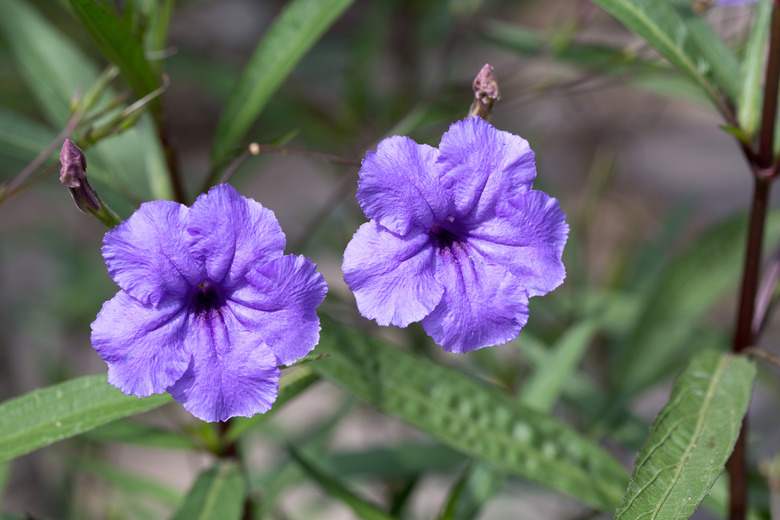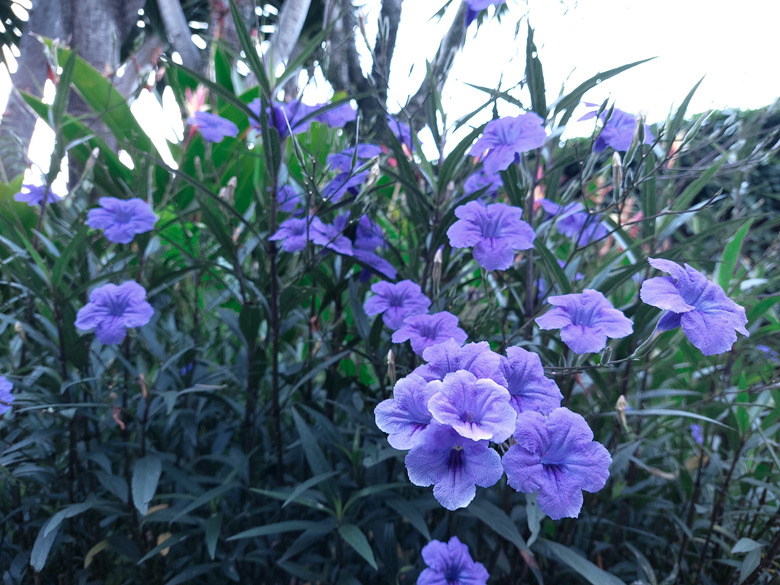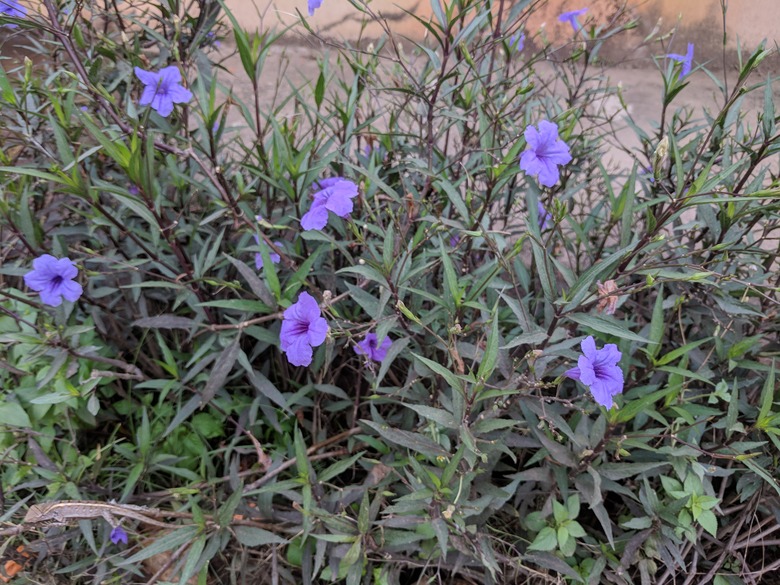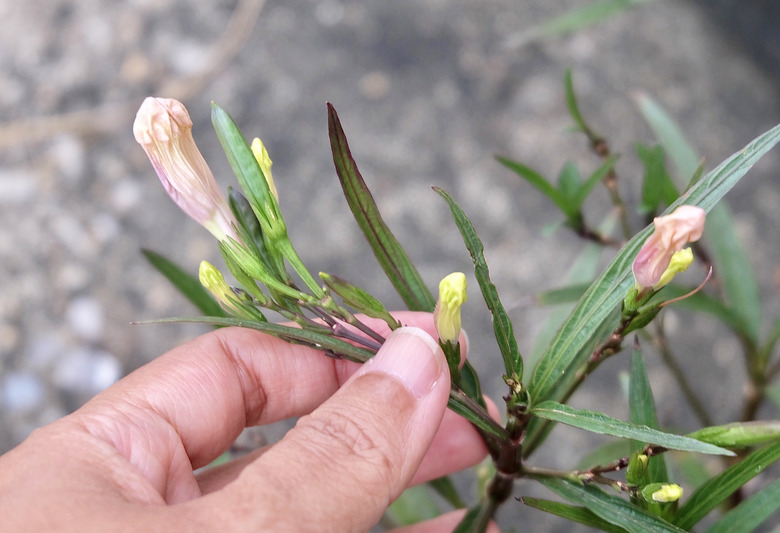How To Transplant Mexican Petunia Plants
Mexican petunias (Ruellia simplex) earned their common name from the appearance of their flowers, but they are not true petunias, which belong to the genus Petunia.
Sometimes called Mexican bluebell or Britton's wild petunias, these tender perennial vines grow best in USDA plant hardiness zones 8a to 10b. They have a tendency to become an invasive species in warm climates because they self-seed and spread via rhizome.
Mexican petunia plants respond well to transplanting. However, it is not always an easy process, because you must lift the whole plant, and any pieces of rhizome left behind in the soil will grow a whole new plant.
About Mexican Petunia Plants
Before digging up and transplanting Mexican petunia plants, it is a good idea to learn about how they grow and why they become invasive.
Mexican petunias are perennial flowering plants grown for their purple flowers and dark green, lance-shaped leaves, which are attached by greenish-purple stems. The flowers attract pollinators, such as hummingbirds, but the plant does not attract browsing animals, which makes it a deer-resistant plant for landscaping.
Mexican petunia plants reproduce through rhizomes and seeds. The rhizomes spread into the surrounding soil, and the flowers produce an abundance of seeds that germinate easily when dropped onto moist soil. Their spreading root system and seeds allow Mexican petunia plants to become highly invasive under the right conditions.
Warning
The invasive tendencies of Mexican petunias are especially bad in humid, moist climates, such as South Carolina and Florida, where this plant is listed as a Category 1 invasive plant by the Florida Exotic Pest Plant Council.
Transplanting a Mexican Petunia Plant
Transplanting a Mexican petunia plant is done in three stages: digging up the plant, dividing the rhizomes and repotting the divisions into new containers or into a new garden bed with the proper root boundaries in place.
Digging It Up
Digging up Mexican petunia plants for transplant requires great attention to detail, because **the entire root ball and all of the surrounding rhizomes must be removed from the soil.**
1. Locate the outer perimeter of the Mexican petunia plant. Measure out 6 inches from the outer perimeter and dig down 10 to 12 inches using a sharp shovel. 2. Work the shovel blade beneath the clump of Mexican petunias. Pry it up from the ground. If it feels stuck to the soil as you dig, there may be rhizomes spread deeper and wider around the hole that must be removed. 3. Remove the clump of Mexican petunias and set it on a work surface, such as a tarp or a large concrete area that can be swept clean afterward.
Go back and excavate the soil around the bottoms and sides of the hole to locate any pieces of rhizome. It is important to remove every bit of rhizome so that new plants don't sprout.
Tip
Bag up and throw away the bits of rhizome into the trash rather than putting them into your compost bin.
Dividing the Rhizomes
Smaller clumps of Mexican petunias can be transplanted whole, but large clumps should be divided into manageable pieces. The division process is simple because Mexican petunias are very forgiving of rough handling and will regrow quickly.
Simply cut the root ball into fist-size divisions using a sharp gardening knife that has been wiped down with disinfectant. Be sure each division has an equal share of roots and foliage, which will allow it to regrow faster.
The divisions can be transplanted into pots or directly into the garden in warm climates within USDA zones 8 to 10. Choose a growing location in full sun with well-draining soil. Mexican petunias love moisture, so they are suited to growing around garden ponds, but they should never be planted near natural bodies of water.
Tip
Be sure to install a root barrier around the bed when growing these potentially invasive plants in the garden.
Repotting the Mexican Petunia
You need two things to repot Mexican petunias: soil and a suitable container. These forgiving plants are not picky about soil type as long as the soil is moist and well-draining. Standard potting soil works well.
1. Fill the bottom of the pot with potting soil. Hold the division in the pot so that the base of the stems is roughly 1 inch below the top of the pot. 2. Add soil in small handfuls until the root ball is completely covered. The crown of the plant, which is where the stems and roots connect, should be right below the surface of the soil. 3. Firm the soil once the pot is completely filled. Water the division until the water runs from the drainage hole at the base of the pot and then add more soil if the roots become exposed.
Tip
A clay pot with drainage holes at the base is best for repotting Mexican petunia divisions, because clay helps regulate soil moisture levels, which will keep the roots healthy as new growth forms.
Growing Mexican Petunia Plants
Mexican petunias are adaptable, low-maintenance plants that require very little care. Potted and garden-grown plants share similar needs with regard to growing conditions and care, although there are some differences too.
Growing Conditions
Mexican petunia plants need full sun in order to bloom well, but they will tolerate some partial shade as well. Outdoors, choose a location in full sun or place potted plants where they will receive direct sun in the morning and late afternoon. Mexican petunia houseplants should be positioned near an east- or west-facing window.
Mexican petunias grow best in moist, well-draining soil. They are not picky about soil type or pH and will tolerate wet soil very well.
Each plant needs 3 to 6 feet of space. Plant closer together when growing this plant as groundcover. To avoid frequent repotting, Mexican petunias should be grown in a pot that is 3 gallons or larger.
Care Requirements
- Water and fertilizer are both required when growing Mexican petunias. Water whenever the soil feels dry below the surface. Outdoor plants need roughly 1 inch of water each week with extra during hot, dry weather.
- Mexican petunias are fast growers that need regular feeding. Feed once a month during the growing season with balanced fertilizer, such as 15-15-15. Potted plants can be fed weekly with water-soluble fertilizer, such as fish emulsion diluted to half the recommended rate.
- Deadheading, or pruning off the spent flowers, will help prevent self-seeding. Snip off the flowers as they fade using sharp pruning shears.
Tip
Deadheading is not necessary for sterile cultivars, such as Purple Showers (Ruellina simplex 'Purple Showers'), which are grown in USDA zones 9 to 11.



